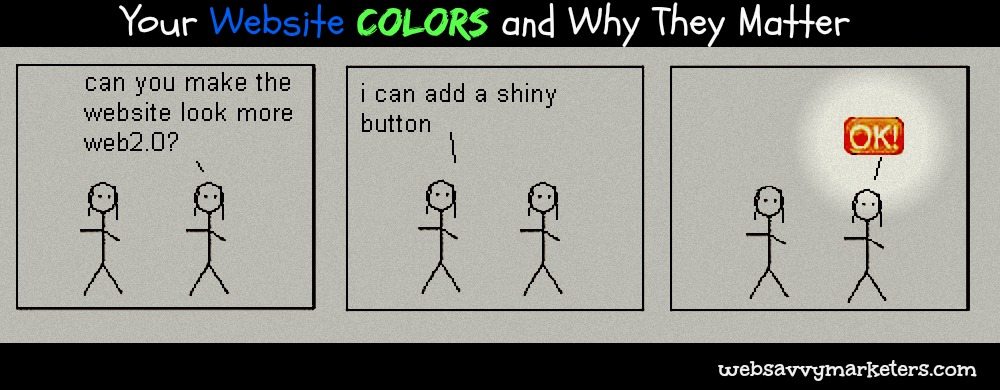 This image is a derivative of web 2.0 by tyger_lyllie, licensed under CC BY.
This image is a derivative of web 2.0 by tyger_lyllie, licensed under CC BY.
What matters most when you make a marketing decision? Science shows that the visual has more impact on people than any of our other senses.
While the visuals of design, power words, and your main image all influence online behavior, your marketing decisions on color matters in how you are perceived.
What are the messages you are sending with your website colors? Are you taking advantage of the full effect of colors? A well-chosen color scheme can give your brand a unique message and convey the right emotions.
Want to know what colors mean to you compared to over 30,000 other responses? Take the color survey to find out.
Color is a key factor in brand recognition
Some of the most recognizable brands rely on color. Check out the power of color on this website and see how well you can identify brands by viewing a small section of their logo.
As this recognizable brand test demonstrates, brand recognition is often color dependent. Recognition can increase by up to 80% through the use of color, according to a much-touted University of Loyola, Maryland study.
Not only that, but brands are growing increasingly color-centric in their identity. Consider the red signature sole of Louboutin. Louboutin filed a trademark infringement claim against Yves Saint Laurent, who dared to use the red sole in their shoes that Louboutin claimed was their visual identity.
Louboutin was unsuccessful in this case, but others have been able to register a color as a trademark. Here’s a link for a list of currently registered trademarks.
Color increases memory
Studies show that pictures with natural colors, or “living colors” are more appealing and are more easily remembered than black and white. Compared to the colors of nature, falsely colored scenes did not improve memory.
“Perhaps designers should be aware that, in order to engage or grab one’s attention (as in advertising), bright colors might well be most suitable,” Felix A. Wichmann said, author of “The Contributions of Color to Recognition Memory for Natural Scenes.”
“If, on the other hand, the aim is more to have an image ‘stick’ in the viewer’s memory, unnatural colors may not be suitable.”
Color has meaning
Color has significant and unique meaning based on cultural, historical, and natural elements. Our perceptions of a color are based on how we have experienced it.
Red is seen as signaling danger, anger, and love. As the color of blood and fire, it was also extremely hard to come by. Ironically, much of the dye used to make red still comes from the cochineal beetle.
Red is one of the top two favorite colors, and is in three-quarters of the world’s flags. All languages have a word for black and white, with red the next color to exist.
The color green is now also a verb. It is intrinsically linked to nature, rebirth, and ecology. There are more shades of green than any other color.
Green is used to describe our moods. If you are nauseated, you are green around the gills. When you’re jealous, you’re green with envy, and when you’re green behind the ears, you are showing your immaturity.
Blue rates as the favorite color for all people. It’s the most common color in corporate branding and is associated with peace, denim, and trust.
It is also the $80 million color that Bing chose for its call-to-action links, making it a similarly colored blue to Google’s shade of blue.
Blue has its share of expressions, including blue laws, blue bloods, blue streak, blue book, and true blue. Without blue and all its varied meanings, we would most assuredly be singing the blues.
The colors of various brands can tell us a lot about what they wished to convey, as this chart shows:
Color choice can impact participation
The button color test has long been a way to see what color influences participation. What they found out might surprise you.
The colors red and green were selected. Red, as we’ve seen, connotes passion, and it is associated with “stop” as well as warning. Green, on the other hand, generally means “go” and points to nature and the environment. It is also the color most used for buttons on websites.
The test showed the red button won over the green button by 21%. While you shouldn’t go out and change your button colors, it’s not a bad idea to test your button colors with your audience and your website to see what the results are.
Color and gender preference
The True Colors survey says that blue ranks #1 for both males and females. Purple doesn’t rank at all with males, but it’s the second favorite color for females.
For least favorite colors, the genders are more similar, with both choosing brown and orange, although in different ranking order.
“Men keep it simple” couldn’t be more accurate. Woman give more names to color variants, allowing for grape, plum, or eggplant for purple, while men like to call purple by its name, not some fruit. (Yes, eggplant is a fruit.)
Men are also more likely to be color blind. Approximately 1 in 12 men and 1 in 20 women are affected by color blindness.
Color blindness is a color vision deficiency that is most common in a red/green deficiency. This means that people will mix up all colors that have some red or green as part of the whole color. For example, a color blind person will be unable to see the difference between blue and purple.
Vischeck simulates what color blind vision is, as well as offers a way to correct images for color blind viewers.
Choose your colors with this information in mind so you can show your true colors with confidence.
